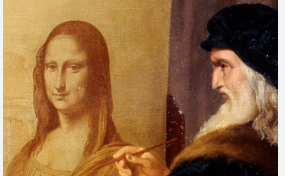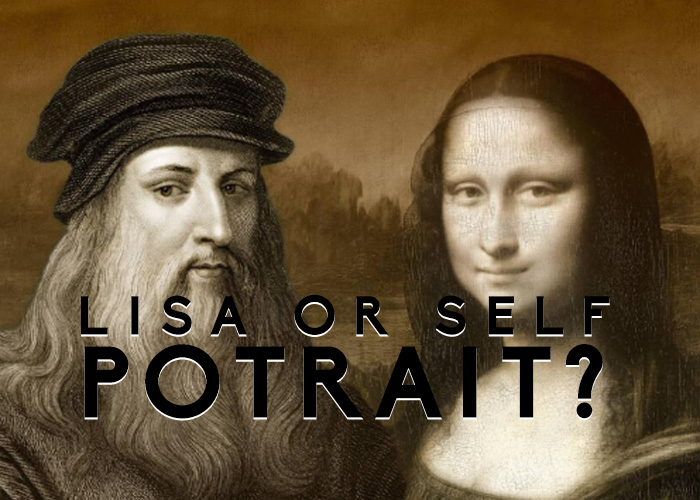The Mona Lisa, painted by Leonardo da Vinci in the early 16th century, is arguably the most famous painting in the world. Her enigmatic smile, haunting gaze, and the mystery surrounding her identity have captivated audiences for centuries. While the prevailing theory is that the painting depicts Lisa Gherardini, the wife of Florentine merchant Francesco del Giocondo, an alternative theory has emerged in recent decades: that the Mona Lisa is not a portrait of a woman at all, but rather a self-portrait of Leonardo da Vinci himself, disguised as a woman.
This theory, while controversial, raises fascinating questions about Leonardo’s intentions, his relationship with gender and identity, and the artistic techniques he employed. In this article, we will explore the origins of this theory, the evidence cited by its proponents, and the counterarguments presented by art historians. We will also delve into Leonardo’s life, his artistic practices, and the cultural context of the Renaissance to better understand whether this theory holds any merit.

The Origins of the Theory
The idea that the Mona Lisa might be a self-portrait of Leonardo da Vinci first gained traction in the late 20th century. In 1987, Lillian Schwartz, a visual artist and researcher, used computer analysis to compare the facial features of the Mona Lisa with those of a known self-portrait of Leonardo da Vinci, drawn in red chalk around 1515. Schwartz claimed that the two faces aligned almost perfectly, suggesting that Leonardo used his own features as the basis for the Mona Lisa.
This theory was further popularized by art historians and writers who pointed to Leonardo’s known fascination with androgyny, his tendency to blur gender lines in his art, and his lifelong habit of incorporating his own features into his works. Proponents of the theory argue that the Mona Lisa is not merely a portrait of a woman, but a deeply personal and symbolic work that reflects Leonardo’s own identity.
Evidence Supporting the Theory
1. Facial Similarities
The most compelling evidence cited by proponents of the theory is the apparent similarity between the facial features of the Mona Lisa and those of Leonardo da Vinci. When the Mona Lisa is superimposed over Leonardo’s self-portrait, the alignment of the eyes, nose, and mouth is striking. While some argue that this could be a coincidence or a result of Leonardo’s artistic style, others see it as deliberate.
Leonardo was known for studying human anatomy in great detail, and his sketches often reveal a deep understanding of facial structure. It is possible that he used his own face as a model for the Mona Lisa, either as a form of self-expression or as an artistic experiment.
2. Leonardo’s Androgynous Figures
Throughout his career, Leonardo exhibited a fascination with androgyny and the blending of masculine and feminine traits. Many of his works, such as John the Baptist and The Virgin of the Rocks, feature figures with ambiguous gender characteristics. The Mona Lisa herself has been described as having a somewhat masculine appearance, with her strong jawline and lack of overtly feminine features.
This blurring of gender lines may reflect Leonardo’s own views on identity and the fluidity of gender. In a time when rigid gender roles were the norm, Leonardo’s art often challenged conventional norms and explored the boundaries between male and female.
3. Leonardo’s Use of Self-Portraiture
Leonardo was known to incorporate his own features into his works. For example, his Vitruvian Man is believed to be based on his own body proportions, and some scholars argue that the face of The Last Supper’s Judas is a self-portrait. If Leonardo frequently used himself as a model, it is not far-fetched to suggest that he might have done the same with the Mona Lisa.
4. The Enigmatic Smile
The Mona Lisa’s smile has been the subject of endless speculation. Some theorists argue that the smile is not that of a woman, but of a man—specifically, Leonardo himself. The smile’s ambiguity and subtlety could be interpreted as a reflection of Leonardo’s own personality, which was known to be enigmatic and introspective.
Counterarguments and Skepticism
While the theory is intriguing, it is not without its critics. Most art historians dismiss the idea that the Mona Lisa is a self-portrait, citing historical records and Leonardo’s own writings as evidence.
1. Historical Records
The most widely accepted theory is that the Mona Lisa depicts Lisa Gherardini, the wife of Florentine merchant Francesco del Giocondo. This theory is supported by Giorgio Vasari, a 16th-century biographer of Renaissance artists, who identified the subject as Lisa del Giocondo. While Vasari’s account has been questioned by some scholars, there is no concrete evidence to suggest that the painting is a self-portrait.
2. Leonardo’s Artistic Practices
Leonardo was known for his meticulous attention to detail and his use of live models. It is unlikely that he would have painted a self-portrait without leaving some indication of his intentions. Additionally, the Mona Lisa was commissioned as a portrait, and it would have been highly unusual for Leonardo to deviate so drastically from the client’s expectations.
3. The Androgyny Argument
While Leonardo did explore androgyny in his art, this does not necessarily mean that the Mona Lisa is a self-portrait. The blending of masculine and feminine traits was a common theme in Renaissance art, reflecting the era’s fascination with humanism and the complexity of human identity.
4. The Smile
The Mona Lisa’s smile is often interpreted as a reflection of Leonardo’s mastery of sfumato, a technique that creates soft, blurred edges. The smile’s ambiguity is more likely a result of this technique than a deliberate attempt to convey Leonardo’s own personality.
Leonardo da Vinci: A Man Ahead of His Time
To fully understand the Mona Lisa and the theory that it might be a self-portrait, it is essential to examine Leonardo da Vinci’s life and work. Leonardo was a true Renaissance man, excelling not only as an artist but also as a scientist, engineer, and inventor. His curiosity and creativity knew no bounds, and his works often reflected his deep interest in the natural world and the human condition.
Leonardo’s fascination with identity and gender may have been influenced by his own experiences. He was known to be highly introspective and private, and his personal life remains shrouded in mystery. Some scholars have speculated that Leonardo may have been homosexual or bisexual, based on his relationships with male apprentices and his lack of interest in women. This speculation, while unproven, adds another layer of complexity to the theory that the Mona Lisa is a self-portrait.
The Cultural Context of the Renaissance
The Renaissance was a time of great intellectual and artistic ferment, marked by a renewed interest in classical antiquity and a focus on humanism. Artists like Leonardo da Vinci sought to capture the complexity of human emotion and identity, often blurring the lines between reality and imagination.
In this context, the Mona Lisa can be seen as a reflection of the Renaissance’s fascination with the human condition. Whether or not the painting is a self-portrait, it undoubtedly embodies Leonardo’s quest to explore the depths of human identity and emotion.
Conclusion: A Theory That Endures
The theory that the Mona Lisa is a self-portrait of Leonardo da Vinci is both fascinating and controversial. While there is no definitive evidence to support the claim, the idea raises important questions about Leonardo’s intentions, his relationship with gender and identity, and the cultural context of the Renaissance.
Ultimately, the Mona Lisa remains an enigma, a masterpiece that continues to captivate and inspire. Whether she is Lisa Gherardini, Leonardo da Vinci in disguise, or something else entirely, her smile will forever remain one of the greatest mysteries in art history.
This article provides a comprehensive exploration of the theory, balancing the arguments for and against it while placing the Mona Lisa and its creator in their historical and cultural context. While the theory may never be proven, it serves as a reminder of the enduring power of art to provoke thought, spark debate, and inspire wonder.

